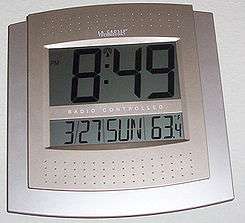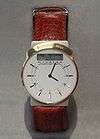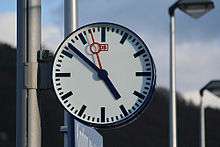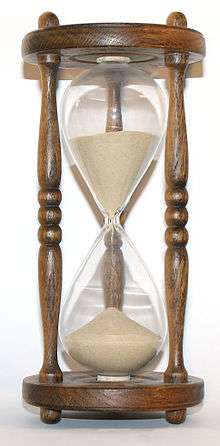Radio clock
A radio clock or radio-controlled clock (RCC) is a clock or watch that is automatically synchronized to a time code transmitted by a radio transmitter connected to a time standard such as an atomic clock. Such a clock may be synchronized to the time sent by a single transmitter, such as many national or regional time transmitters, or may use the multiple transmitters used by satellite navigation systems such as GPS. Such systems may be used to automatically set clocks or for any purpose where accurate time is needed. RC clocks may include any feature available for a clock, such as alarm function, display of ambient temperature and humidity, broadcast radio reception, etc.

One common style of radio-controlled clock uses time signals transmitted by dedicated terrestrial longwave radio transmitters, which emit a time code that can be demodulated and displayed by the radio controlled clock. The radio controlled clock will contain an accurate time base oscillator to maintain timekeeping if the radio signal is momentarily unavailable. Other radio controlled clocks use the time signals transmitted by dedicated transmitters in the shortwave bands. Systems using dedicated time signal stations can achieve accuracy of a few tens of milliseconds.
GPS satellite receivers also internally generate accurate time information from the satellite signals. Dedicated GPS timing receivers are accurate to better than 1 microsecond; however, general-purpose or consumer grade GPS may have an offset of up to one second between the internally calculated time, which is much more accurate than 1 second, and the time displayed on the screen.
Other broadcast services may include timekeeping information of varying accuracy within their signals.
Single transmitter
Radio clocks synchronized to a terrestrial time signal can usually achieve an accuracy within a hundredth of a second relative to the time standard,[1] generally limited by uncertainties and variability in radio propagation. Some timekeepers, particularly watches such as some Casio Wave Ceptors which are more likely than desk clocks to be used when travelling, can synchronise to any one of several different time signals transmitted in different regions.
Longwave and shortwave transmissions
Radio clocks depend on coded time signals from radio stations. The stations vary in broadcast frequency, in geographic location, and in how the signal is modulated to identify the current time. In general, each station has its own format for the time code.
List of radio time signal stations
| Frequency | Callsign | Country Authority | Location | Aerial type | Power | Remarks |
|---|---|---|---|---|---|---|
| 25 kHz | RJH69 | VNIIFTRI | Vileyka 54°27′47″N 26°46′37″E | Triple umbrella antenna[lower-alpha 1] | 300 kW | This is Beta time signal.[2] The signal is transmitted in non-overlapping time: 02:00–02:20 UTC RAB99 04:00–04:25 UTC RJH86 06:00–06:20 UTC RAB99 07:00–07:25 UTC RJH69 08:00–08:25 UTC RJH90 09:00–09:25 UTC RJH77 10:00–10:25 UTC RJH86 11:00–11:20 UTC RJH63 |
| RJH77 | VNIIFTRI | Arkhangelsk 64°21′29″N 41°33′58″E | Triple umbrella antenna[lower-alpha 2] | 300 kW | ||
| RJH63 | VNIIFTRI | Krasnodar 44°46′25″N 39°32′50″E | Umbrella antenna[lower-alpha 3] | 300 kW | ||
| RJH90 | VNIIFTRI | Nizhny Novgorod 56°10′20″N 43°55′38″E | Triple umbrella antenna[lower-alpha 4] | 300 kW | ||
| RJH86[2][lower-alpha 5] | VNIIFTRI | Bishkek 43°02′29″N 73°37′09″E | Triple umbrella antenna[lower-alpha 6] | 300 kW | ||
| RAB99 | VNIIFTRI | Khabarovsk 48°29′29″N 134°48′59″E | Umbrella antenna[lower-alpha 7] | 300 kW | ||
| 40 kHz | JJY | NICT | Mount Otakadoya, Fukushima 37°22′21″N 140°50′56″E | Capacitance hat, height 250 m | 50 kW | Located near Fukushima[3] |
| 50 kHz | RTZ | VNIIFTRI | Irkutsk 52°25′41″N 103°41′12″E | Umbrella antenna | 10 kW | |
| 60 kHz | JJY | NICT | Mount Hagane, Kyushu 33°27′54″N 130°10′32″E | Capacitance hat, height 200 m | 50 kW | Located on Kyūshū Island[3] |
| MSF | NPL | Anthorn, Cumbria 54°54′27″N 03°16′24″W | Triple T-antenna[lower-alpha 8] | 17 kW | Range up to 1,500 km. Before 1 April 2007, the signal was transmitted from Rugby, Warwickshire 52°21′33″N 01°11′21″W | |
| WWVB | NIST | Near Fort Collins, Colorado[4] 40°40′41″N 105°02′48″W | Two capacitance hats, height 122 m | 70 kW | Received through most of mainland USA[3] | |
| 66.66 kHz | RBU | VNIIFTRI | Taldom, Moscow 56°43′59″N 37°39′47″E | Umbrella antenna[lower-alpha 9] | 50 kW | Before 2008, transmitter located at 55°44′14″N 38°09′04″E |
| 68.5 kHz | BPC | NTSC | Shangqiu, Henan 34°56′54″N 109°32′34″E | 4 guyed masts, arranged in a square | 90 kW | 21 hours per day, with a 3 hour break from 05:00–08:00 (China Standard Time) daily (21:00–24:00 UTC)[5] |
| | Discontinued as of 1 January 2012 | |||||
| 77.5 kHz | DCF77 | PTB | Mainflingen, Hessen 50°00′58″N 09°00′29″E | Vertical omni-directional antennas with top-loading capacity, height 150 m[6] | 50 kW | Located southeast of Frankfurt am Main with a range of up to 2,000 km[3][7] |
| BSF | Zhongli 25°00′19″N 121°21′55″E | T-antenna[lower-alpha 11] | [8] | |||
| 100 kHz[lower-alpha 12] | BPL | NTSC | Pucheng, Shaanxi 34°27′23″N 115°50′13″E | Single guyed lattice steel mast | 800 kW | Loran-C compatible format signal on air from 05:30 to 13:30 UTC,[9] with a reception radius up to 3,000 km[10] |
| RNS-E | VNIIFTRI | Bryansk 53°08′00″N 34°55′00″E | 5 guyed masts | 800 kW | CHAYKA compatible format signal[2] 04:00–10:00 UTC and 14:00–18:00 UTC | |
| RNS-V | VNIIFTRI | Alexandrovsk-Sakhalinsky 51°05′00″N 142°43′00″E | Single guyed mast | 400 kW | CHAYKA compatible format signal[2] 23:00–05:00 UTC and 11:00–17:00 UTC | |
| 129.1 kHz[lower-alpha 13] | DCF49 | PTB | Mainflingen 50°00′58″N 09°00′29″E | T-antenna | 100 kW | EFR radio teleswitch[11] time signal only (no reference frequency) FSK ± 170 Hz 200 baud |
| 135.6 kHz[lower-alpha 13] | HGA22 | PTB | Lakihegy 47°22′24″N 19°00′17″E | Single guyed mast | 100 kW | |
| 139 kHz[lower-alpha 13] | DCF39 | PTB | Burg bei Magdeburg 52°17′13″N 11°53′49″E | Single guyed mast | 50 kW | |
| 162 kHz[lower-alpha 14] | TDF | ANFR | Allouis 47°10′10″N 02°12′16″E | Two guyed steel lattice masts, height 350 m, fed on the top | 800 kW | AM-broadcasting transmitter, located 150 km south of Paris with a range of up to 3,500 km, using PM with encoding similar to DCF77[lower-alpha 15] |
| 198 kHz[lower-alpha 14][lower-alpha 16] | BBC Radio 4 | NPL | Droitwich 52.2955°N 2.1063°W | T-aerial[lower-alpha 17] | 500 kW[12] | Additional (50 kW) transmitters is at Burghead and Westerglen. The time signal is transmitted by 25 bit/s phase modulation.[13] |
| 2.5 MHz | BPM | NTSC | Pucheng, Shaanxi 34°56′54″N 109°32′34″E | (BCD time code on 125 Hz sub-carrier not yet activated) 07:30–01:00 UTC[14] | ||
| WWV | NIST | Near Fort Collins, Colorado 40°40′41″N 105°02′48″W | Broadband monopole | 2.5 kW | Binary-coded decimal (BCD) time code on 100 Hz sub-carrier | |
| WWVH | NIST | Kekaha, Hawaii 21°59′16″N 159°45′46″W | 5 kW | |||
| 3.33 MHz | CHU | NRC | Ottawa, Ontario 45°17′40″N 75°45′27″W | 3 kW | 300 baud Bell 103 time code | |
| 4.996 MHz | RWM | VNIIFTRI | Taldom, Moscow 55°44′14″N 38°09′04″E | 10 kW | CW | |
| 5 MHz | BPM | NTSC | Pucheng, Shaanxi 34°56′54″N 109°32′34″E | BCD time code on 125 Hz sub-carrier. 00:00–24:00 UTC[14] | ||
| HLA | KRISS | Daejeon 36°23′14″N 127°21′59″E | 2 kW | |||
| WWV | NIST | Near Fort Collins, Colorado 40°40′41″N 105°02′48″W | Broadband monopole | 10 kW[lower-alpha 18] | BCD time code on 100 Hz sub-carrier | |
| WWVH | NIST | Kekaha, Hawaii 21°59′16″N 159°45′46″W | 10 kW | |||
| YVTO | Caracas | 1 kW | ||||
| 7.85 MHz | CHU | NRC | Ottawa, Ontario 45°17′40″N 75°45′27″W | 10 kW | 300 baud Bell 103 time code | |
| 9.996 MHz | RWM | VNIIFTRI | Taldom, Moscow 55°44′14″N 38°09′04″E | 10 kW | CW | |
| 10 MHz | BPM | NTSC | Pucheng, Shaanxi 34°56′54″N 109°32′34″E | (BCD time code on 125 Hz sub-carrier not yet activated) 00:00–24:00 UTC[14] | ||
| LOL | SHN | Buenos Aires | 2 kW | Observatorio Naval Buenos Aires[15] | ||
| WWV | NIST | Near Fort Collins, Colorado 40°40′41″N 105°02′48″W | Broadband monopole | 10 kW | BCD time code on 100 Hz sub-carrier | |
| WWVH | NIST | Kekaha, Hawaii 21°59′16″N 159°45′46″W | 10 kW | |||
| PPE[16] | Rio de Janeiro, RJ 22°53′44″S 43°13′27″W[16] | Horizontal half-wavelength dipole[16] | 1 kW[16] | Maintained by National_Observatory_(Brazil) | ||
| 14.67 MHz | CHU | NRC | Ottawa, Ontario 45°17′40″N 75°45′27″W | 3 kW | 300 baud Bell 103 time code | |
| 14.996 MHz | RWM | VNIIFTRI | Taldom, Moscow 55°44′14″N 38°09′04″E | 10 kW | CW | |
| 15 MHz | BPM | NTSC | Pucheng, Shaanxi 34°56′54″N 109°32′34″E | (BCD time code on 125 Hz sub-carrier not yet activated) 01:00–09:00 UTC[14] | ||
| WWV | NIST | Near Fort Collins, Colorado 40°40′41″N 105°02′48″W | Broadband monopole | 10 kW | BCD time code on 100 Hz sub-carrier | |
| WWVH | NIST | Kekaha, Hawaii 21°59′16″N 159°45′46″W | 10 kW | |||
| 20 MHz | WWV | NIST | Near Fort Collins, Colorado 40°40′41″N 105°02′48″W | Broadband monopole | 2.5 kW | BCD time code on 100 Hz sub-carrier |
| 25 MHz | WWV | NIST | Near Fort Collins, Colorado 40°40′41″N 105°02′48″W | Broadband monopole | 1.0 kW | Schedule: variable (experimental broadcast) |
| MIKES | MIKES | Espoo, Finland 60°10′49″N 24°49′35″E | λ/4 sloper antenna | 0.2 kW[17] | 1 kHz amplitude modulation similar to DCF77. As of 2017 the transmission is discontinued until further notice.[18] |
Descriptions
- 3 umbrella antennas, fixed on 3 guyed tubular masts, insulated against ground with a height of 305 metres and 15 guyed lattice masts with a height of 270 metres
- 3 umbrella antennas, fixed on 18 guyed lattice masts, height of central masts: 305 metres
- umbrella antenna, fixed on 13 guyed lattice masts, height of central mast: 425 metres
- 3 umbrella antennas, fixed on 3 guyed tubular masts, insulated against ground with a height of 205 metres and 15 guyed lattice masts with a height of 170 metres
- in air RJH66
- 3 umbrella antennas, fixed on 18 guyed lattice masts, height of central masts: 276 metres
- umbrella antenna, fixed on 18 guyed lattice masts arranged in 3 rows, height of central masts: 238 metres
- 3 T-antennas, spun 150 metres above ground between two 227 metres high guyed grounded masts in a distance of 655 metres
- umbrella antenna, fixed on a 275 metres high central tower insulated against ground and five 257 metres high lattice masts insulated against ground in a distance of 324 metres from the central tower
- T-antenna spun between two 125 metres tall, grounded free-standing lattice towers in a distance of 227 metres
- T-antenna spun between two telecommunication towers in a distance of 33 metres
- Frequency for radio navigation system
- Frequency for radio teleswitch system
- Frequency for AM-broadcasting
- and requiring a more complex receiver for demodulating time signal
- since 1988, before 200 kHz
- Droitwich uses a T-aerial suspended between two 213 m guyed steel lattice radio masts, which stand 180 m apart.
- Time signal article says 2.5 kW
A current list of times signal stations is published by the BIPM as an appendix to their annual report; the appendix includes coordinates of transmitter sites, operating schedules for stations, and the uncertainty of the carrier frequency of transmitters.[19][18]
Many other countries can receive these signals (JJY can sometimes be received in New Zealand, Western Australia, Tasmania, Southeast Asia, parts of Western Europe and the Pacific Northwest of North America at night), but success depends on the time of day, atmospheric conditions, and interference from intervening buildings. Reception is generally better if the clock is placed near a window facing the transmitter. There is also a propagation delay of approximately 1 ms for every 300 km the receiver is from the transmitter.
Clock receivers
A number of manufacturers and retailers sell radio clocks that receive coded time signals from a radio station, which, in turn, derives the time from a true atomic clock.
One of the first radio clocks was offered by Heathkit in late 1983. Their model GC-1000 "Most Accurate Clock" received shortwave time signals from radio station WWV in Fort Collins, Colorado. It automatically switched between WWV's 5, 10, and 15 MHz frequencies to find the strongest signal as conditions changed through the day and year. It kept time during periods of poor reception with a quartz-crystal oscillator. This oscillator was disciplined, meaning that the microprocessor-based clock used the highly accurate time signal received from WWV to trim the crystal oscillator. The timekeeping between updates was thus considerably more accurate than the crystal alone could have achieved. Time down to the tenth of a second was shown on an LED display. The GC-1000 originally sold for US$250 in kit form and US$400 preassembled, and was considered impressive at the time. Heath Company was granted a patent for its design.[20][21]
In the 2000s (decade) radio-based "atomic clocks" became common in retail stores; as of 2010 prices start at around US$15 in many countries.[22] Clocks may have other features such as indoor thermometers and weather station functionality. These use signals transmitted by the appropriate transmitter for the country in which they are to be used. Depending upon signal strength they may require placement in a location with a relatively unobstructed path to the transmitter and need fair to good atmospheric conditions to successfully update the time. Inexpensive clocks keep track of the time between updates, or in their absence, with a non-disciplined quartz-crystal clock, with the accuracy typical of non-radio-controlled quartz timepieces. Some clocks include indicators to alert users to possible inaccuracy when synchronization has not been recently successful.
Other broadcasts
- Attached to other broadcast stations
- Broadcast stations in many countries have carriers precisely synchronized to a standard phase and frequency, such as the BBC Radio 4 longwave service on 198 kHz, and some also transmit sub-audible or even inaudible time-code information, like the Radio France longwave transmitter on 162 kHz. Attached time signal systems generally use audible tones or phase modulation of the carrier wave.
- Teletext (TTX)
- Digital text pages embedded in television video also provide accurate time. Many modern TV sets and VCRs with TTX decoders can obtain accurate time from Teletext and set the internal clock. However the TTX time can vary up to 5 minutes.[23]
Many digital radio and digital television schemes also include provisions for time-code transmission.
- Digital Terrestrial Television
- The DVB and ATSC standards have 2 packet types that send time and date information to the receiver. Digital television systems can equal GPS stratum 2 accuracy (with short term clock discipline) and stratum 1 (with long term clock discipline) provided the transmitter site (or network) supports that level of functionality.
- VHF FM Radio Data System (RDS)
- RDS can send a clock signal with sub-second precision but with an accuracy no greater than 100 ms and with no indication of clock stratum. Not all RDS networks or stations using RDS send accurate time signals. The time stamp format for this technology is Modified Julian Date (MJD) plus UTC hours, UTC minutes and a local time offset.
- L-band and VHF Digital Audio Broadcasting
- DAB systems provide a time signal that has a precision equal to or better than Digital Radio Mondiale (DRM) but like FM RDS do not indicate clock stratum. DAB systems can equal GPS stratum 2 accuracy (short term clock discipline) and stratum 1 (long term clock discipline) provided the transmitter site (or network) supports that level of functionality. The time stamp format for this technology is BCD.
- Digital Radio Mondiale (DRM)
- DRM is able to send a clock signal, but one not as precise as navigation satellite clock signals. DRM timestamps received via shortwave (or multiple hop mediumwave) can be up to 200 ms off due to path delay. The time stamp format for this technology is BCD.
Gallery
 A low frequency (LF) radio clock
A low frequency (LF) radio clock LF time signal receiver
LF time signal receiver World's first radio clock wrist watch, Junghans Mega (analog model)
World's first radio clock wrist watch, Junghans Mega (analog model)- Citizen Attesa Eco-Drive ATV53-3023 analog-digital chronograph with 4 area Radio Controlled reception (North America, Europe, China, Japan)
- Radio controlled analog wall clock
 Radio controlled alarm clock
Radio controlled alarm clock The DCF77 time signal is used by organizations like the Deutsche Bahn railway company to synchronize their station clocks
The DCF77 time signal is used by organizations like the Deutsche Bahn railway company to synchronize their station clocks
Multiple transmitters
A radio clock receiver may combine multiple time sources to improve its accuracy. This is what is done in satellite navigation systems such as the Global Positioning System. GPS, Galileo and GLONASS satellite navigation systems have one or more caesium, rubidium or hydrogen maser atomic clocks on each satellite, referenced to a clock or clocks on the ground. Dedicated timing receivers can serve as local time standards, with a precision better than 50 ns.[24][25][26][27] The recent revival and enhancement of LORAN, a land-based radio navigation system, will provide another multiple source time distribution system.
GPS clocks
Many modern radio clocks use the Global Positioning System to provide more accurate time than can be obtained from terrestrial radio stations. These GPS clocks combine time estimates from multiple satellite atomic clocks with error estimates maintained by a network of ground stations. Due to effects inherent in radio propagation and ionospheric spread and delay, GPS timing requires averaging of these phenomena over several periods. No GPS receiver directly computes time or frequency, rather they use GPS to discipline an oscillator that may range from a quartz crystal in a low-end navigation receiver, through oven-controlled crystal oscillators (OCXO) in specialized units, to atomic oscillators (rubidium) in some receivers used for synchronization in telecommunications. For this reason, these devices are technically referred to as GPS-disciplined oscillators.
GPS units intended primarily for time measurement as opposed to navigation can be set to assume the antenna position is fixed. In this mode, the device will average its position fixes. After approximately a day of operation, it will know its position to within a few meters. Once it has averaged its position, it can determine accurate time even if it can pick up signals from only one or two satellites.
GPS clocks provide the precise time needed for synchrophasor measurement of voltage and current on the commercial power grid to determine the health of the system.[28]
Astronomy timekeeping
Although any satellite navigation receiver that is performing its primary navigational function must have an internal time reference accurate to a small fraction of a second, the displayed time is often not as precise as the internal clock. Most inexpensive navigation receivers have one CPU that is multitasking. The highest-priority task for the CPU is maintaining satellite lock—not updating the display. Multicore CPUs for navigation systems can only be found on high end products.
For serious precision timekeeping, a more specialized GPS device is needed. Some amateur astronomers, most notably those who time grazing lunar occultation events when the moon blocks the light from stars and planets, require the highest precision available for persons working outside large research institutions. The Web site of the International Occultation Timing Association[29] has detailed technical information about precision timekeeping for the amateur astronomer.
Daylight saving time
Various of the formats above include a flag indicating the status of daylight saving time (DST) in the home country of the transmitter. This signal is typically used by clocks to adjust the displayed time to meet user expectations.
See also
References
- Michael A Lombardi. "How Accurate is a Radio Controlled Clock?" (PDF).
- Standard Time and Frequency Signals (PDF) (in Russian), retrieved 2018-07-15 — official signal specification.
- Dennis D. McCarthy, P. Kenneth Seidelmann Time: From Earth Rotation to Atomic Physics Wiley-VCH, 2009 ISBN 3-527-40780-4 page 257
- "NIST Radio Station WWVB". NIST. Retrieved 18 March 2014.
- "BPC". National Time Service Center, Chinese Academy of Sciences. National Time Service Center, Chinese Academy of Sciences. Archived from the original on 17 June 2012. Retrieved 16 March 2013.
- Yvonne Zimber (2007-05-09). "DCF77 transmitting facilities". Retrieved 2010-05-02.
- "Synchronizing time with DCF77 and MSF60". 090917 compuphase.com
- "A Time Station Signal Project for Taiwan".
- "长波授时 (Longwave time signal)". National Time Service Center, Chinese Academy of Sciences. National Time Service Center, Chinese Academy of Sciences. Retrieved 16 March 2013.
- "科研成果 (Research achievements)". National Time Service Center, Chinese Academy of Sciences. National Time Service Center, Chinese Academy of Sciences. Retrieved 16 March 2013.
- "PTB time monitor". — in german
- "Radio stations in London, England". Retrieved 2016-04-26.
Birmingham, Droitwich, 500 kW + Blackwall Tunnel + Rotherhithe Tunnel
- "L.F. RADIO-DATA: Specification of BBC phase-modulated transmissions on long-wave" (PDF) (published 2006-10-24). December 1984.
The BBC long-wave a.m. transmitter network carries a low bit-rate data signal, in addition to the normal programme signal modulation. The data signal is conveyed by phase-modulation of the carrier
- "短波授时 (Shortwave time signal)". National Time Service Center, Chinese Academy of Sciences. National Time Service Center, Chinese Academy of Sciences.
- Information on the Official Time and Standard Frequency, in Spanish
- "Rádio-Difusão de Sinais Horários". Observatório Nacional. Retrieved 2012-02-23.
- "QSL: MIKES Time Station, Espoo, Finland". SWL DX Blog. 14 May 2014. Retrieved 2016-10-11. Reproduces a QSL letter from MIKES with technical details.
- BIPM Annual Report on Time Activities – Time Signals, retrieved 2018 July 31.
- BIPM Annual Report on Time Activities 2010, pages 85-93, retrieved 2011 September 12.
- "copy of Heathkit catalog page, Christmas 2003". Retrieved 2008-07-19.
- US patent 4,582,434, David Plangger and Wayne K. Wilson, Heath Company, "Time corrected, continuously updated clock", issued 1986-04-15
- " Radio controlled clock £19.95 Archived 2013-02-16 at Archive.today
- "How's your GHD8015F2 operating? — Personal Video Recorders — Digital Spy Forums". 100506 digitalspy.co.uk
- "datasheet i-Lotus TX Oncore" (PDF).
- "Symmetricom XL-GPS".
- "datasheet Trimble Resolution SMT GG" (PDF).
- "datasheet u-blox NEO/LEA-M8T" (PDF).
- KEMA, Inc. (November 2006). "Substation Communications: Enabler of Automation / An Assessment of Communications Technologies". UTC — United Telecom Council: 3. Cite journal requires
|journal=(help) - International Occultation Timing Association
External links
| Look up radio clock in Wiktionary, the free dictionary. |
| Wikimedia Commons has media related to Radio clocks. |
- IOTA Observers Manual This manual from the International Occultation Timing Association has very extensive details on methods of accurate time measurement.
- NIST website: WWVB Radio Controlled Clocks
- NTP Project Development Website

